The Mauryan Empire | History for UPSC CSE PDF Download
Introduction
The Maurya Empire was a powerful and large empire that existed during the Iron Age in ancient India. It was founded by Chandragupta Maurya in Magadha around 322 BCE and lasted until 185 BCE. The empire covered most of South Asia, especially after conquering the Indo-Gangetic Plain. Its capital was Pataliputra, which is the modern city of Patna in Bihar. Under Ashoka the Great, the Maurya Empire became the largest empire in Indian history, spreading over about 5 million square kilometres.
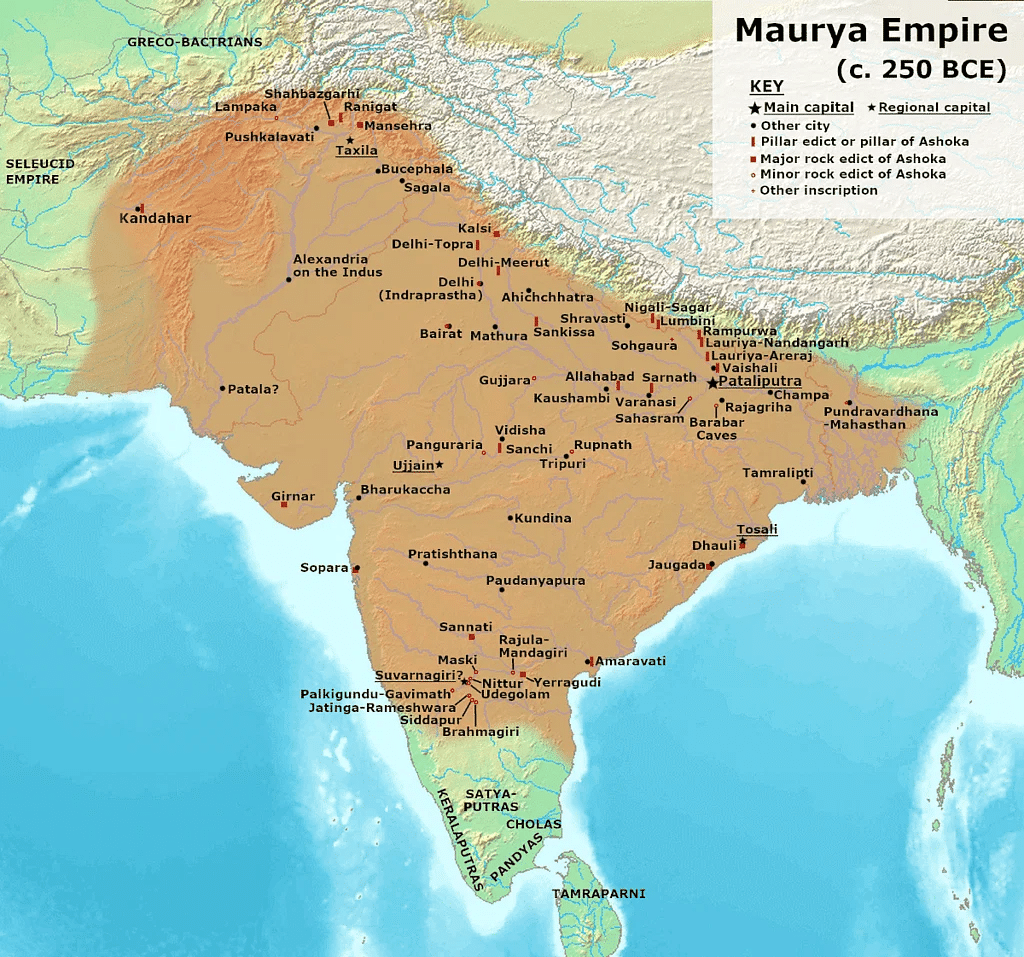 Mauryan Empire
Mauryan Empire
Mauryan Empire – Rise of the Mauryas
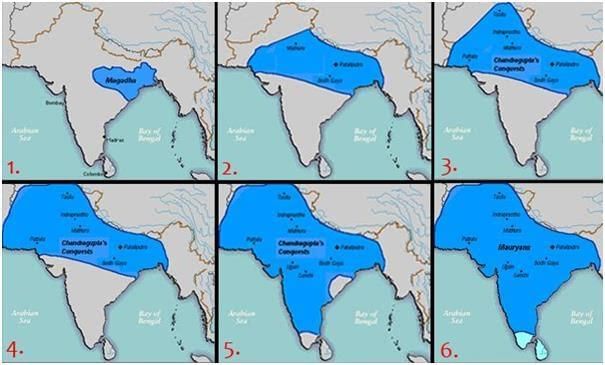 Rise of Mauryas
Rise of Mauryas
- Before the Maurya Empire, the Nanda Empire ruled over most of the Indian Subcontinent. The Nandas were known for their military strength and economic power, having conquered various Mahajanapadas.
- According to several legends, Chanakya travelled to Pataliputra, Magadha, the capital of the Nanda Empire where Chanakya worked for the Nandas as a minister.
- However, Chanakya was insulted by Emperor Dhana Nanda, of the Nanda dynasty and Chanakya which motivated him to seek revenge and plan the overthrow of the Nanda Empire.
- To safeguard himself, Chanakya fled to Taxila, a prominent centre of learning, where he took up a teaching position.
- During his time in Taxila, Chanakya observed young men training for battle and identified the leadership potential in a young man named Chandragupta.
- Dhana Nanda, the last ruler of the Nanda dynasty, was widely disliked due to his heavy taxation policies.
- Also, post-Alexander’s invasion of North-Western India, that region faced a lot of unrest from foreign powers. They were ruled by Indo-Greek rulers.
- With Chanakya's guidance, Chandragupta seized the throne by defeating Dhana Nanda in 321 BC.
Mauryan Empire – Genealogy
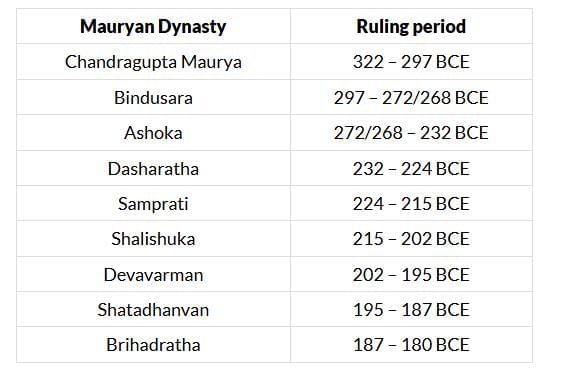
Important Rulers of the Mauryan Empire
Though the Mauryan Dynasty had several rulers only 3 among them are famous and important in a point of view. They are;
- Chandragupta Maurya (322-298 BCE)
- Bindusara (298-272 BCE)
- Ashoka (268-232 BCE)
Founder of the Mauryan Empire - Chandragupta Maurya (322 - 298 BCE)
- The beginnings of Chandragupta Maurya are shrouded in mystery.
- The earliest Greek texts describe him as being of non-warrior ancestry.
- According to Hindu texts, he was a disciple of Kautilya, born of lowly origin, probably to a Shudra woman.
- Most Buddhist texts describe him as a Kshatriya.
- It is commonly believed that he was an orphaned youth from a poor background, who was trained by Kautilya.
- In Greek records, he is referred to as Sandrokottos.
- After Alexander abandoned his invasion of India in 324 BC, Chandragupta defeated several Greek-ruled towns in the northwestern region within a year.
- This plan was devised by Kautilya and executed by Chandragupta. They had formed a mercenary army.
- From there, they moved eastward towards Magadha.
Around 321 BC, Chandragupta defeated Dhana Nanda in a series of battles, laying the foundation of the Maurya Empire. - In 305 BC, he signed a treaty with Seleucus Nicator, through which he gained Balochistan, eastern Afghanistan, and the land west of the Indus.
He also married the daughter of Seleucus Nicator. - Chandragupta followed an expansionist policy that brought almost the entire Indian subcontinent under his rule, except for a few areas like Kalinga and parts of the far south.
- He ruled from 321 BC to 297 BC.
- He later abdicated the throne in favour of his son, Bindusara, and went to Karnataka with the Jain monk Bhadrabahu.
- Having embraced Jainism, Chandragupta is believed, according to Jain tradition, to have starved himself to death at Shravanabelagola.
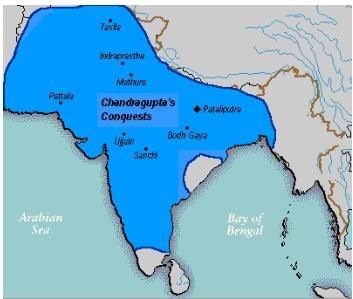
Imperial Organization of Chandragupta Maurya
- Chandragupta Maurya was an autocratic ruler, which means he held complete control over the government.
- As mentioned in the Arthashastra, a king was expected to be a role model and work for the welfare of the people.
- According to the Greek ambassador Megasthenes, the king was advised by a council of wise ministers.
- One of the main features of his rule was the maintenance of a huge army.
- The Mauryan military was three times stronger than the Nandas, and they also had a navy.
- Chanakya (Kautilya) played a key role in shaping the internal and foreign policies of the empire.
Chanakya (Kautilya)
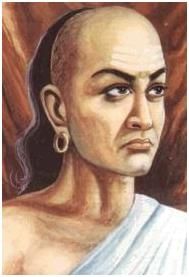 Kautilya
Kautilya
- Chandragupta Maurya's teacher and Chief Minister.
- He was a Taxila teacher and scholar. Vishnugupta and Chanakya are two more names.
- He was also a minister in Bindusara's palace.
- He is recognised as being the main planner behind the Nanda throne usurpation and the development of the Mauryan Empire via his disciple, Chandragupta.
- Arthashastra is a book on statecraft, economics, and military strategy that he composed.
- The work is divided into 15 volumes and 180 chapters. The major concept is divided into three sections:
- King, Ministerial Council, and Government Departments.
- Criminal and civil law.
- War diplomacy
- It also includes information on commerce and markets, a mechanism for screening ministers and spies, royal responsibilities, ethics, social welfare, agriculture, mining, metallurgy, medicine, and forests, among other things.
- Chanakya is often known as the "Indian Machiavelli."
Second Ruler of the Mauryan Empire – Bindusara (297 BC – 272 BC)
- Bindusara was the son of Chandragupta, the Mauryan Empire's founder. Several texts, including the Puranas and the Mahavamsa, attest to this.
- Throughout his term, Chanakya served as Prime Minister.
- Bindusara maintains diplomatic relations with Greece. Deimachus was the Seleucid emperor Antiochus I's envoy to Bindusara's court.
- Bindusara, unlike his father Chandragupta (who eventually converted to Jainism), belonged to the Ajivika sect. Bindusara's master, Pingalavatsa (Janasana), was an Ajivika Brahmin.
- Bindusara died around the 270s BCE, according to historical sources.
- Bindusara is credited for extending the Mauryan Empire to Mysore.
- He united sixteen nations into the Mauryan Empire, conquering nearly the whole Indian peninsula.
Third Ruler – Ashoka the Great (268 BC – 232 BC)
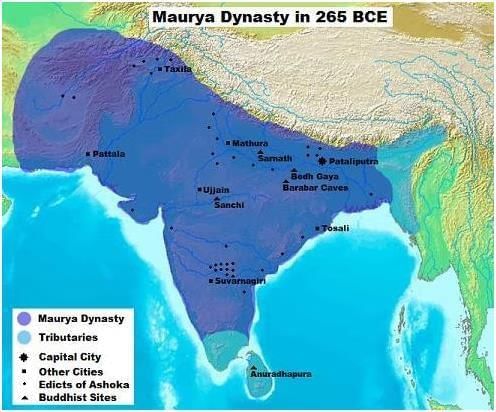 Mauryan Dynasty in 265 BCE
Mauryan Dynasty in 265 BCE
- Ashoka the Great, was the son of Mauryan Emperor Bindusara and Subhadrangi. Chandragupta Maurya's grandson.
- His other names were Devanampiya (Sanskrit Devanampriya, which means Beloved of the Gods) and Piyadasi.
- One of India's greatest monarchs.
- He was born in 304 BC.
- His rule lasted from 268 BC until 232 BC, when he died.
- As a young prince, Ashoka was a superb commander who suppressed revolts in Ujjain and Takshashila.
- As emperor, he was ambitious and aggressive, re-establishing the Empire's supremacy in southern and western India. But it was his conquest of Kalinga (262–261 BCE) that proved to be the defining event of his life.
- He became a Buddhist. A Buddhist monk named Moggaliputta Tissa became his guru.
- In 247 BC, Ashoka presided over the third Buddhist Council in Pataliputra, which was presided over by Moggaliputta Tissa.
Rise to power
- Ashoka was not the eldest son of Bindusara and so was not the heir presumptive.
- Bindusara wanted his elder son Susima to be crowned the next king.
- But was trained in the military and weapons and showed great skills as an administrator when he was made the governor of Ujjain.
- In the war of succession that followed Bindusara’s death in 272 BC, Ashoka emerged victorious aided by his father’s ministers.
- When he became the king, he was said to be bad-tempered, ruthless and very cruel.
- He even built a torture chamber to torture his prisoners to death. This earned him the moniker Chandashoka (cruel Ashoka).
- Once he became the king, he started expanding his empire by conquest. In the ninth year of his reign, he waged a war with Kalinga (in present-day Odisha).
Conversion to Buddhism
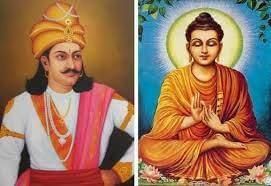 Ashoka Conversion to Buddhism
Ashoka Conversion to Buddhism
- The battle with Kalinga fought in 265 BC was personally led by Ashoka and he was able to vanquish the Kalingas.
- Whole cities were destroyed and more than a hundred thousand people were killed in the war.
- The horrors of war disturbed him so much that he decided to shun violence for the rest of his life and turned to Buddhism.
- Ashoka’s 13th Rock Edict describes the Kalinga War vividly.
- He now became Dharmashoka (the pious Ashoka) from Chandashoka.
- In about 263 BC Ashoka converted to Buddhism. Moggaliputta Tissa, a Buddhist monk became his mentor.
- Ashoka even conducted the third Buddhist Council at Pataliputra in 250 BC under Moggaliputta Tissa’s presidency.
Ashoka’s Dhamma (or Dharma in Sanskrit)
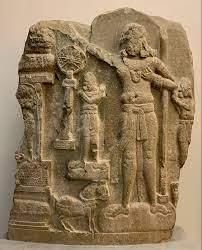 Ashoka's Dhamma
Ashoka's Dhamma
- Ashoka established the idea of paternal kinship.
- He regarded all his subjects as his children and believed it was the king’s duty to look after the welfare of the subjects.
- Through his edicts, he said everybody should serve parents, revere teachers, and practice ahimsa and truthfulness.
- He asked everyone to animal slaughter and sacrifice.
- He expounded on the humane treatment of animals, servants, and prisoners.
- He advocated tolerance towards all religions.
- He sought conquest through Dhamma and not war.
- He sent missions abroad to spread the word of the Buddha. Notably, he sent his son Mahinda and daughter Sanghamitra to Sri Lanka.
- Most of his edicts are written in Pali and Prakrit in Brahmi script. Some are written in the Kharoshti and Aramaic scripts. There are some edicts written in Greek as well. The language depends on the location of the pillar.
- Sources of information about Ashoka
- There are two main sources: Buddhist sources and Ashoka’s edicts.
- James Prinsep, a British antiquary and colonial administrator was the first person to decipher Ashoka’s edicts.
- Ashokavadana (Sanskrit) written in the second century AD, Dipavamsa and Mahavamsa (Sri Lankan Pali chronicles) give most of the information about Ashoka.
The Decline of the Mauryan Empire
The Mauryan empire began to disintegrate with the end of Ashoka's reign in 232 BCE. Several factors led to the decline and fall of the vast empire. The causes are widely debated by scholars.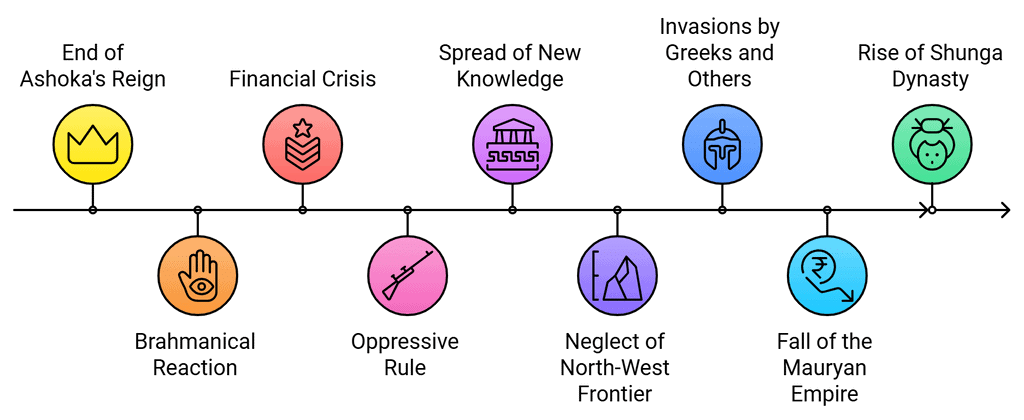
Brahmanical Reaction
- Though Ashoka adopted the policy of religious tolerance, he was against the killing of animals and birds and also prohibited the superstitious sacrifices and rituals performed by women.
- This anti-sacrifice attitude of Ashoka brought about loss to the Brahmanical society, who lived on the offers made in the name of sacrifices.
- This turned the Brahmanas against Ashoka and developed some kind of antipathy towards him.
Financial Crisis
- The Mauryan empire was known for maintaining the largest army and the largest regiment of officers in ancient times.
- This led to huge expenditures on payment to the army and the bureaucrats, thus resulting in economic constraints.
- Ashoka made huge grants out of the royal treasury to the Buddhist monks, which soon ran empty.
- In later periods, the images made of gold were melted to meet the expenses.
Oppressive Rule
- During the reign of Bindusara, the people of Taxila complained about the misrule of the wicked bureaucrats. This was sorted by appointing Ashoka.
- This was repeated during the reign of Ashoka. He ordered the mahamatras to not torture the people without due cause.
- He introduced a rotation of officers in Ujjain, Taxila and Tosali to address this issue. However, the oppression continued to exist in the outlying provinces.
Spread of the New Knowledge
- As a result of the expansion of the Mauryan empire, the knowledge of the material advantages of the Mauryas spread to central India, Kalinga and Deccan.
- With this, the Gangetic basin which was the heart of the empire lost its special advantage.
- New kingdoms such as Shungas, Kanvas, and Chetis were founded and expanded based on this material knowledge gained from the Magadha.
Neglect of the North-West Frontier
- Ashoka was preoccupied with missionary activities in their homeland and abroad. He failed to concentrate on the passages of the North West Frontier.
- The nomadic people were looked upon as a serious threat to India and China. So the then ruler of China constructed the Great Wall of China to shield the empire against these attacks.
- No such measures were made by Ashoka. As a result, when Scythians approached India, they forced the Parthians, the Shakas and the Greeks to move towards India.
- The Greeks invaded north Afghanistan and set up an empire known as Bactria. They were the first to invade India which was followed by a series of invasions.
Sources of Mauryan Empire
The sources of the Mauryan Empire can be seen as follows:
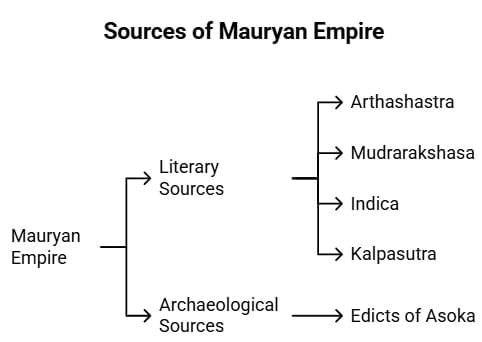
Literary Sources
The literary sources of Mauryan Empire are as follows:
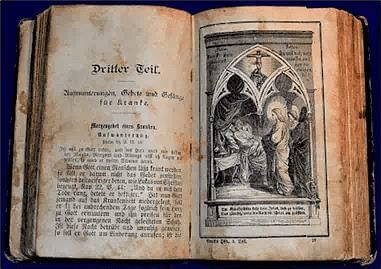 Literary Sources1. Arthashastra
Literary Sources1. Arthashastra
- Arthashastra was written by Kautilya in Sanskrit.
- Kautilya was the contemporary of Chandragupta Maurya
- Arthashastra deals with the entire legal and bureaucratic framework required for the administration of the kingdom
- It was compiled a few centuries after the Maurya rule, yet this book contains authentic information about the Mauryan administration.
- It serves to be the most important source of the Mauryan empire.
- It contains 15 books and 180 chapters and they are divided into three broad divisions.
2. Mudrarakshasa
- Mudrarakshasa is a drama written by Visakadata in Sanskrit.
- Though this piece of work belongs to the Gupta era, it gives an image of the socio-economic conditions under the Mauryas.
- The victory of Chandragupta Maurya over Nandas under the guidance of Kautilya is elaborated in this.
3. Indica
- Indica was written by Megasthenes, a Greek ambassador who was sent by Selecus to Chandragupta Maurya’s court.
- He wrote an account of the administration of the capital city, Pataliputra and the Mauryan empire as well.
- His works were not available in full and the fragments of his works were collected and compiled by the Greek writers. This compilation was published under the name Indika.
4. Kalpasutra
- Kalpasutra is an important Jain text that contains the biographies of the Tirthankaras, including Mahavira.
- It also provides information about historical figures like Chandragupta Maurya, especially his association with Jainism and his later life under the influence of Jain monk Bhadrabahu.
Archaeological Sources
One important source of information about the Mauryan Empire is the Edicts of Ashoka.
1. Edicts of Asoka: These are the earliest inscriptions that have been understood. They were first read and understood by James Prinsep in 1837.
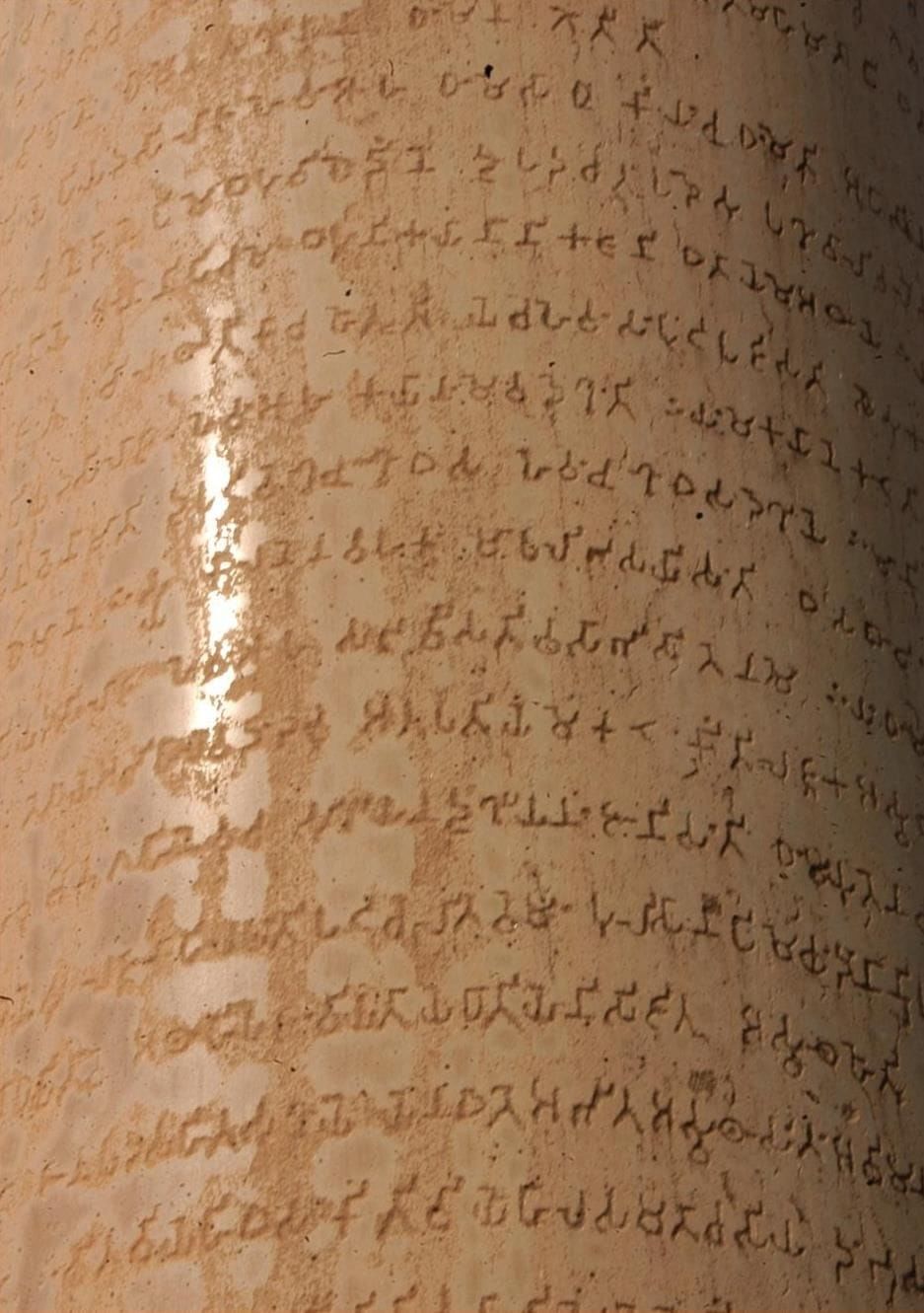 Edicts of Ashoka
Edicts of Ashoka
Later Mauryas
- After Ashoka’s death in 232 BC, the power and glory of the Mauryan Empire started to decline.
- According to the Vishnu Purana, Ashoka had seven successors, but not much is known about their rule.
- The empire likely split into two parts:
- Western Region – Ruled by Kunala (Ashoka’s son) and later by Sampriti (Kunala’s son)
- Eastern Region – Ruled by Brihadratha from Pataliputra
- During this time, Indo-Greek invaders started entering northwestern India.
By around 180 BC, they had almost completely replaced the later Mauryan rulers in that region. - The last Mauryan ruler was Brihadratha, who was the seventh king after Ashoka.
He was killed by his commander-in-chief Pushyamitra in 187 BC. - Pushyamitra then became king and started a new royal family called the Shunga Dynasty.
To practice questions of "The Mauryan Empire", attempt the tests given below:
|
216 videos|855 docs|219 tests
|
FAQs on The Mauryan Empire - History for UPSC CSE
| 1. What is the Mauryan Empire? |  |
| 2. Who was the founder of the Mauryan Empire? |  |
| 3. Who was the second ruler of the Mauryan Empire? |  |
| 4. Who was Chanakya and what was his role in the Mauryan Empire? |  |
| 5. Who was Ashoka the Great and what was his significance in the Mauryan Empire? |  |






















